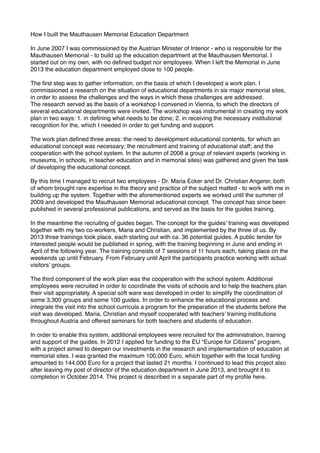
How I built the Mauthausen Memorial Education Department
- 1. How I built the Mauthausen Memorial Education Department In June 2007 I was commissioned by the Austrian Minister of Interior - who is responsible for the Mauthausen Memorial - to build up the education department at the Mauthausen Memorial. I started out on my own, with no defined budget nor employees. When I left the Memorial in June 2013 the education department employed close to 100 people. The first step was to gather information, on the basis of which I developed a work plan. I commissioned a research on the situation of educational departments in six major memorial sites, in order to assess the challenges and the ways in which these challenges are addressed. The research served as the basis of a workshop I convened in Vienna, to which the directors of several educational departments were invited. The workshop was instrumental in creating my work plan in two ways: 1. in defining what needs to be done; 2. in receiving the necessary institutional recognition for the, which I needed in order to get funding and support. The work plan defined three areas: the need to development educational contents, for which an educational concept was necessary; the recruitment and training of educational staff; and the cooperation with the school system. In the autumn of 2008 a group of relevant experts (working in museums, in schools, in teacher education and in memorial sites) was gathered and given the task of developing the educational concept. By this time I managed to recruit two employees - Dr. Maria Ecker and Dr. Christian Angerer, both of whom brought rare expertise in the theory and practice of the subject matted - to work with me in building up the system. Together with the aforementioned experts we worked until the summer of 2009 and developed the Mauthausen Memorial educational concept. The concept has since been published in several professional publications, and served as the basis for the guides training. In the meantime the recruiting of guides began. The concept for the guides’ training was developed together with my two co-workers, Maria and Christian, and implemented by the three of us. By 2013 three trainings took place, each starting out with ca. 36 potential guides. A public tender for interested people would be published in spring, with the training beginning in June and ending in April of the following year. The training consists of 7 sessions of 11 hours each, taking place on the weekends up until February. From February until April the participants practice working with actual visitors’ groups. The third component of the work plan was the cooperation with the school system. Additional employees were recruited in order to coordinate the visits of schools and to help the teachers plan their visit appropriately. A special soft ware was developed in order to simplify the coordination of some 3,300 groups and some 100 guides. In order to enhance the educational process and integrate the visit into the school curricula a program for the preparation of the students before the visit was developed. Maria, Christian and myself cooperated with teachers’ training institutions throughout Austria and offered seminars for both teachers and students of education. In order to enable this system, additional employees were recruited for the administration, training and support of the guides. In 2012 I applied for funding to the EU “Europe for Citizens” program, with a project aimed to deepen our investments in the research and implementation of education at memorial sites. I was granted the maximum 100,000 Euro, which together with the local funding amounted to 144,000 Euro for a project that lasted 21 months. I continued to lead this project also after leaving my post of director of the education department in June 2013, and brought it to completion in October 2014. This project is described in a separate part of my profile here.